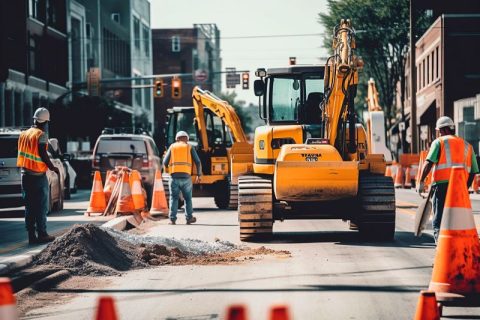Ever been jolted by a pothole on your way to work or while running errands? It’s a sharp reminder of the beating our roads take over time. These potholes are more than just a bump in the road; they’re early warnings of possible bigger issues ahead for both our vehicles and the roads we rely on every day.
Now, picture this: roads so well-maintained that spotting a pothole becomes a rarity. It may sound too good to be true, but it’s entirely achievable with some proactive care and practical strategies. That said, let’s take a closer look at how we can make this dream a reality, ensuring our roads stay in prime condition for the long haul.
Understanding Potholes
Potholes begin as minor wear and tear on the road. Throw in some water, a freeze here, a thaw there, and before you know it, you’re dealing with the road’s version of a cavity. This cycle starts when moisture seeps into the pavement, freezes, expands, and then leaves behind a void when it melts. The constant traffic turns these small voids into big problems.
But why do some areas seem to be more prone to potholes? A lot has to do with the road’s construction and its ability to drain water. Poor drainage means water lingers, leading to trouble and, inevitably, potholes. It’s a recurring issue, especially if the road’s foundation wasn’t strong to begin with.

Strategies for Pothole Prevention
Potholes aren’t inevitable; with foresight and the right tactics, we can significantly reduce their occurrence. Here’s how to tackle the problem head-on and pave the way for longer-lasting roads:
-
Proper Road Construction and Materials
The battle against potholes starts beneath the surface. Choosing the right materials—like asphalt mixed with rubber or advanced composites—can dramatically extend a road’s lifespan. These materials adapt better to temperature changes and heavy traffic, resisting the common causes of wear and tear.
Working with an asphalt paving contractor who utilizes cutting-edge construction techniques, such as proper compaction and layering, is crucial. This ensures that the foundation is solid and less prone to cracking, laying the groundwork for roads that withstand the rigors of daily use and the elements.
-
Regular Maintenance and Inspections
Just like cars, roads need regular check-ups to stay in prime condition. Routine inspections can catch the small cracks and weaknesses that, if ignored, could evolve into troublesome potholes.
By enlisting a professional asphalt paving service to implement a consistent maintenance schedule, including timely repairs and sealant applications, we create a protective barrier. This strategic care safeguards the road’s surface and structure from water intrusion and the ensuing damage, ensuring longevity and safety for all road users.
-
Effective Drainage Systems
Good drainage is critical in preventing potholes. Designing roads with adequate drainage channels and maintaining clear pathways for water runoff are critical steps.
These measures ensure that water, the primary catalyst for pothole formation through the freeze-thaw cycle, doesn’t linger on the surface or beneath, preserving the integrity of the roadbed.
-
Community Involvement and Reporting Systems
The power of community observation shouldn’t be underestimated. When drivers and residents are encouraged to report emerging road issues, authorities can respond more swiftly to early signs of damage.
Modern technology facilitates this process, with mobile apps and online reporting systems creating a direct line of communication between the community and road maintenance teams.
By adopting these strategies, we lay the groundwork for roads that not only last longer but also provide a safer and more enjoyable driving experience. It’s a collective effort that starts with construction and continues through to everyday vigilance and care.
Long-Term Benefits of Pothole Prevention
Preventing potholes before they emerge isn’t just about immediate benefits. It sets the stage for enduringly better roads.
-
Reduced Repair Costs
Investing in prevention is cost-effective. By avoiding the need for extensive repairs and emergency interventions, we save significant public funds.
Regular maintenance and quality construction spread out expenditures, reducing the financial burden on communities and governments. It’s a classic case of spending a little now to save a lot later.
-
Increased Road Safety
Safe roads save lives. With fewer potholes to dodge, the risk of accidents diminishes, making every journey safer for drivers, cyclists, and pedestrians alike.
Well-maintained roads also mean less wear and tear on vehicles, contributing to overall road safety and preventing potential mishaps caused by sudden swerves or stops.
-
Improved Public Satisfaction
Smooth roads lead to smoother moods. When people can travel without the constant annoyance of potholes, public satisfaction with infrastructure management skyrockets.
It’s not just about comfort; it’s about trust in the entities responsible for keeping our roads safe and navigable.
-
Environmental Benefits
Effective pothole prevention strategies can have a positive impact on the environment. Better roads mean more efficient fuel consumption and lower emissions, as vehicles don’t have to traverse rough surfaces.
Additionally, using sustainable materials and practices in road construction and maintenance further enhances the environmental benefits.
Adopting a proactive approach to road maintenance doesn’t just patch up problems; it paves the way for a future where every trip is safer, greener, and more enjoyable. It’s an investment in the longevity of our roads and the well-being of our communities.
Final Thoughts
In the grand scheme of things, proactive pothole prevention goes beyond mere maintenance—it reflects our dedication to safer, more reliable roads. Through smart strategies and community engagement, we’re not just repairing roads; we’re enhancing our daily travel experiences.
So, the next time you enjoy a smooth drive on a well-maintained road, remember the effort and planning that keep it that way. Together, with the right approach and attention to detail, we can ensure that our journeys are as smooth as the roads we travel on.
